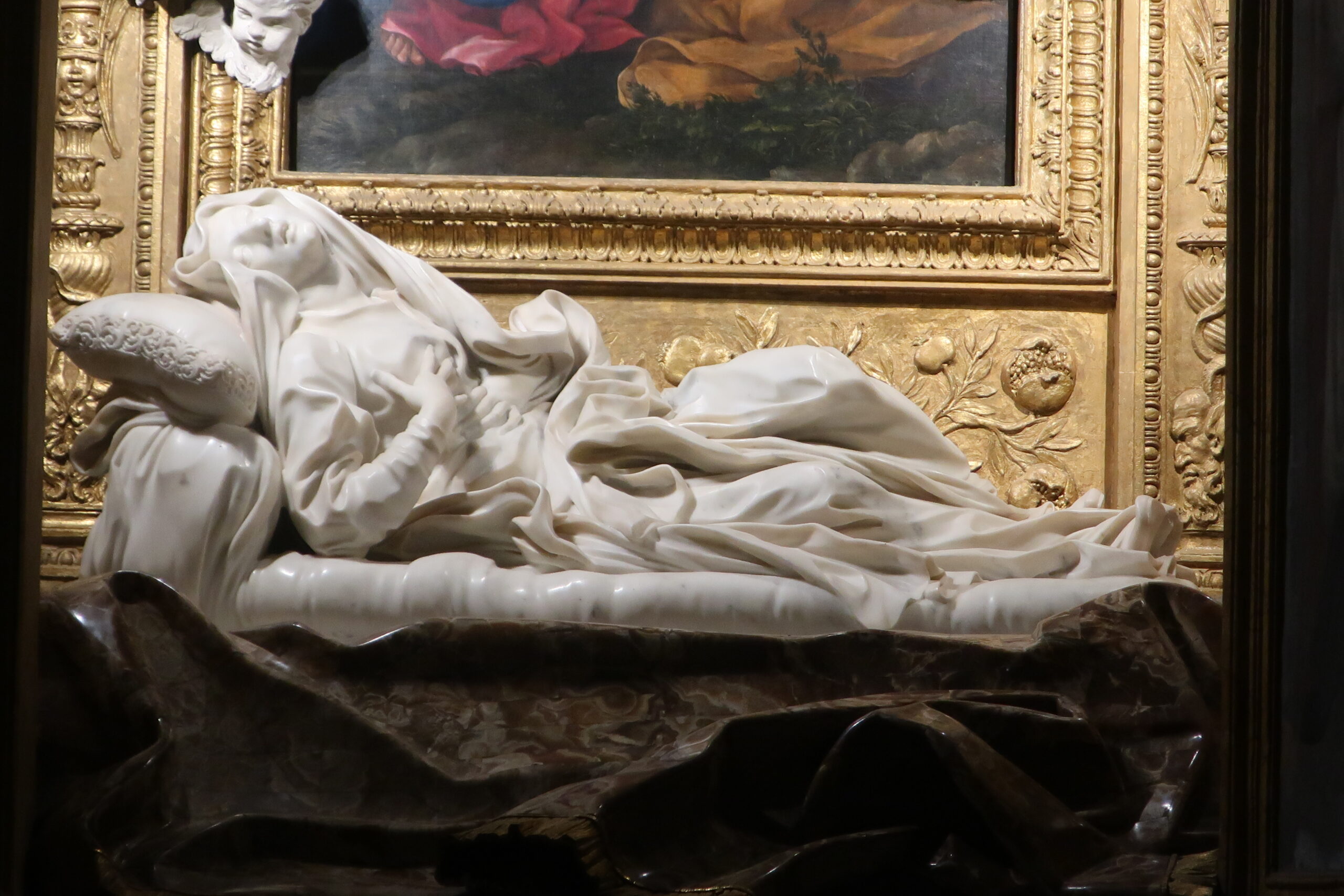Table of Contents
(39) "Ludovica Antoni, the Blessed" - A powerful work from Bernini's last years in the church of San Francesco a Ripa!
After a long look at Bernini's life and works, we are now entering his final years. Although Bernini had achieved many glories, his last years were unfortunately a difficult one.
This is because Clement IX, who had supported Bernini with deep understanding and affection, died after only two years on the throne. Let us look at the accession of the new Pope in 1670, which triggered Bernini's hardship.
The Accession of Clement X and the Slander of Bernini
election of the Popewas unusually protracted. The papal election began on December 20, and it was not until April 29 of the following year that Emilio Artieri was finally elected. The new Pope, Clement X, was from an old Roman family and was 81 years old. Therefore, there was no hope for ambitious art projects, and the financial situation of the papacy was so tight that it would not allow such projects to be undertaken. Meanwhile, the Pope's family was preoccupied with the addition and decoration of their own palazzo during the Pope's lifetime. It is said that this work was continued even at night with the lights on.
The year 1670, the year of Clement X's accession to the throne, marked the beginning of a depressing last year for Bernini. Having lost his papal patronage, he immediately faced criticism. In a document dated August 2 of the same year, Bernini was accused by the authorities of being "an agitator who had led the Pope into a futile extravagance at a time of such misery," a charge he would repeat again and again. The long and defamatory letter I have already mentioned regarding the "Equestrian Statue of Constantine," which was unveiled on November 1 of the same year, can be seen as one of a series of such criticisms by the anti-Bernini faction.
To make matters worse, on December 20, his brother Luigi committed a crime and was forced to flee Rome. At this time, Bernini did everything possible to prevent the incident from becoming a scandal. First, he begged Queen Christina to shelve the trial, and then he took on a number of tasks without payment in order to enlist the help of the Altieri family. The case was settled in 1675, when Luigi was pardoned by the Holy Year's pardon.
Masumi Ishinabe, Yoshikawa KobunkanBernini, Giant Star of Baroque Art.p197-198
*some line breaks.
Bernini's depressing last years began in this way. Losing his backing, Bernini was subjected to intense criticism. He was forced to take on many jobs without pay because of incidents involving his relatives. He had to beg and plead for help. It could not have been more humiliating for him, the reigning king of the baroque in Rome.
And it is important to note that the first half of the quoteThe new Pope, Clement X, came from an old Roman family and was 81 years old. He was 81 years old and from an old family in Rome, so there was no room for ambitious art projects, and the papacy was in dire financial straits that would not allow it. Meanwhile, the Pope's family was preoccupied with the addition and decoration of their own palazzo during the Pope's lifetime. It is said that this work was continued even at night with the lights on.This is the part that says.
It is understandable that the papacy's finances were strained, so no large-scale construction was undertaken. However, the Pope's family seemed to be very wealthy and busy building their own houses and villas.
(15) Bernini, a child prodigy who displayed Mozart-level talent and an astonishing intellect, as well as the special social conditions of 16th-century Rome."As I mentioned in my article "The Construction of Churches and Public Facilities", the construction of churches and public facilities was also a welfare policy in Rome, where there were no industries of this kind. It is true that the construction of churches and public facilities was also a welfare policy in Rome, where there were no industries of any kind.
However, Rome's finances were now under pressure. It was no longer possible to carry out large-scale construction work. It was a sinking ship, so to speak. That is why the Pope's family took this opportunity to build a palazzo for themselves (not to mention their financial resources).
Of course, these practices did not begin at this time, but were commonplace in the Vatican in recent centuries. It had become customary for the papal family to monopolize and prosper in important posts. However, there is also a complicated background that forced them to do so. It is impossible to talk about the intricacies of this area here. If you are interested in this matter, please refer to the book by Masumi Ishinabe.Rome of the Popes.and by Hiroshi EmuraKarl V: The Glorious Days of the Habsburgsby M. Viroli.The Life of Machiavelli: The Mystery of His Smile.I would highly recommend such as
Now, Bernini in his last years, I can't help but think that he was sacrificed as a scapegoat for such a sinking great ship Rome. It is true that his art cost a lot of money. There have been criticisms against it in the past. But even so, I think the criticism of Bernini during this period is unfair.
St. Ludovica Albertoni" in the Church of San Francesco a Ripa
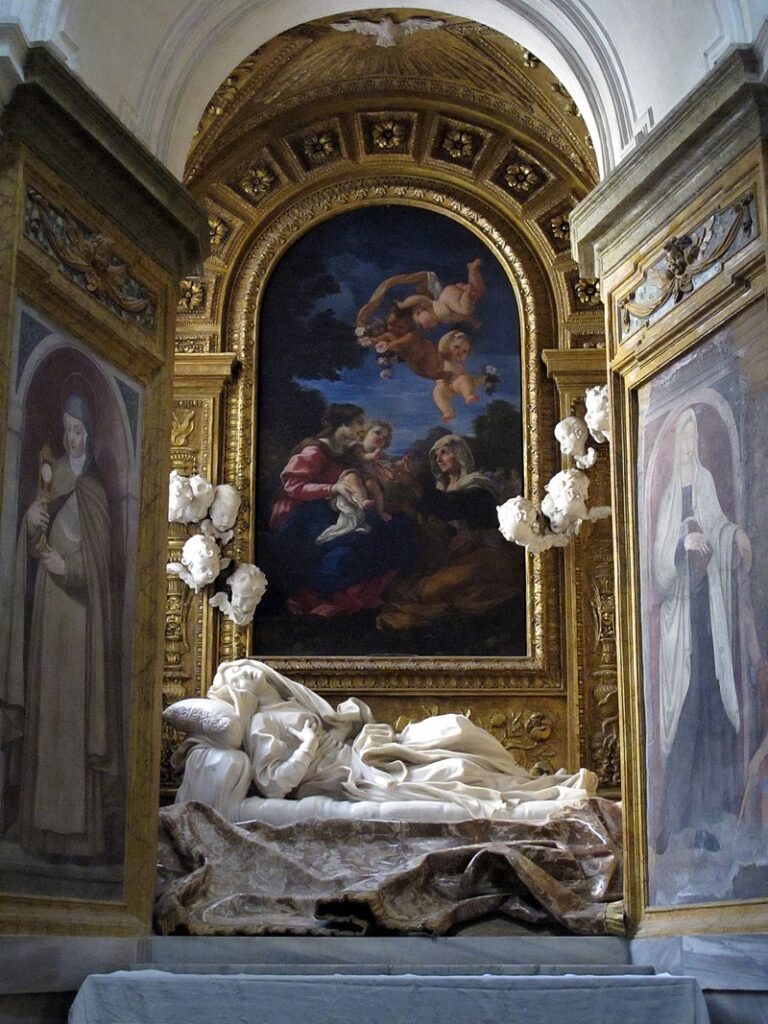
Bernini was now over seventy years old, and his wife predeceased him in 1673. Despite this, his creativity showed no sign of waning. Even during the less vigorous reign of Clement X, he produced several outstanding works. Chief among them is the statue of Blessed Ludovica Albertoni. This work is located in an inconspicuous church, San Francesco a Ripa, in the Trastevere district of Rome. It is a masterpiece of Bernini's work during this period, although it is not well known to the general public for this reason. It is believed to have been commissioned by Cardinal Paluzzi degli Albertoni shortly after Clement X's accession to the throne, and was produced between 1671 and 744. Cardinal Albertoni was related to the Pope's family, the Altieri, and was the person on whom the Pope relied most heavily.
She was born in 1473 and married a nobleman from Trastevere at the age of 20. After 13 years of marriage, she lost her husband and struggled to raise three children. She died in 1533, and her tombstone, made at that time, already bears the name Gospel Ludovica. However, it was not until January 1671, during the reign of Clement X, that the Pope officially recognized this folk belief and beatified her. To commemorate the Blessed Virgin, Cardinal Albertoni commissioned Bellini to decorate the altar of his chapel in San Francesco a Ripa. Bellini accepted the job without compensation in the aftermath of the Luigi affair.
Masumi Ishinabe, Yoshikawa KobunkanBernini, Giant Star of Baroque Art.p201-203
*some line breaks.
As noted at the end of this commentary, Bernini undertook this work without compensation. The result, however, is a masterpiece of Bernini's last years.
Let's continue to look at the description of this statue.
Bernini's skilled mystical expression
The Albertoni Chapel, dating from the 16th century, is located in the left aisle of the church. Bernini built an altar at the back of the chapel with windows on both sides to let in light, and decorated it with a statue of the Blessed Virgin and Child by Bacicchio and a statue of the Blessed Virgin carved by Bernini himself. Seen from the nave, the altar decoration shines in the dark recesses of the chapel as if it were the only place enveloped in mystical light. In particular, the marble statue of Ludovica casts a soft glow that is truly mystical (nowhere is church lighting more detrimental to the effect of a work than in this chapel. If there are lights on, they should be turned off.) The effect is similar to that of the Raimondi and Cornaro chapels, but more concentrated and much simpler in conception than the former. Therefore, we feel a deeper religiosity and mystery in it.
It is also important not to overlook the contribution of Bernini's first-rate attention to color to this effect. In other words, he has set the painting in the background and used colored marble for the base cloth so that the white marble statue stands out well. The folds of Ludovica's robe are carved deeply to bring out the effect of the light that filters through the stone skin or drifts on the surface, thereby achieving a mystical expression of the statue.
Ludovica lies with her hands on her chest, bliss on her face. There are two interpretations of this statue: some believe that it represents the Blessed Mother in death, while others believe that it represents a state of mystical union with God. The pose is reminiscent of Maria Raggi in her death, but it does not match the biographer's description of Ludovica holding a cross in her arms, so the latter theory may be correct. At any rate, when we approach the statue and observe the details such as the hand expression, it is impossible not to be struck by the undiminished power of Bernini's vision.
Yet despite the expressiveness and dramatic forms, the overall impression is strangely quiet and profound. Pope Hennessy, author of a three-volume book on Italian sculpture, is rather indifferent to Bernini and Baroque sculpture, but is very favorable to his work of this period. Of the angels of San Tandrea de Fratte, for example, he writes, "They speak to us not with the insensitive egotism of a dramatist or designer, but with the reserved voice of a dedicated marble sculptor," while of the Ludovica statue, he writes, "It is as unthinkable in the previous period, It is made with a maturity and a disdain for vanity that was unthinkable in previous periods. If he is to be accepted as one of Italy's greatest artists, it will not be by Saint Teresa, but by this supreme statue.
Although I do not necessarily agree with Pope Hennessy's assessment of Bernini's work, and I do not agree with this argument, I must say that it is certainly an insight. The evangelical Ludovica has a spiritual depth appropriate to its age, as well as a creativity that makes it hard to believe that it was made by a man in his mid-seventies.
Masumi Ishinabe, Yoshikawa KobunkanBernini, Giant Star of Baroque Art.p
*some line breaks.
The Raimondi and Cornaro chapels mentioned in the first half of this commentary were previously introduced.
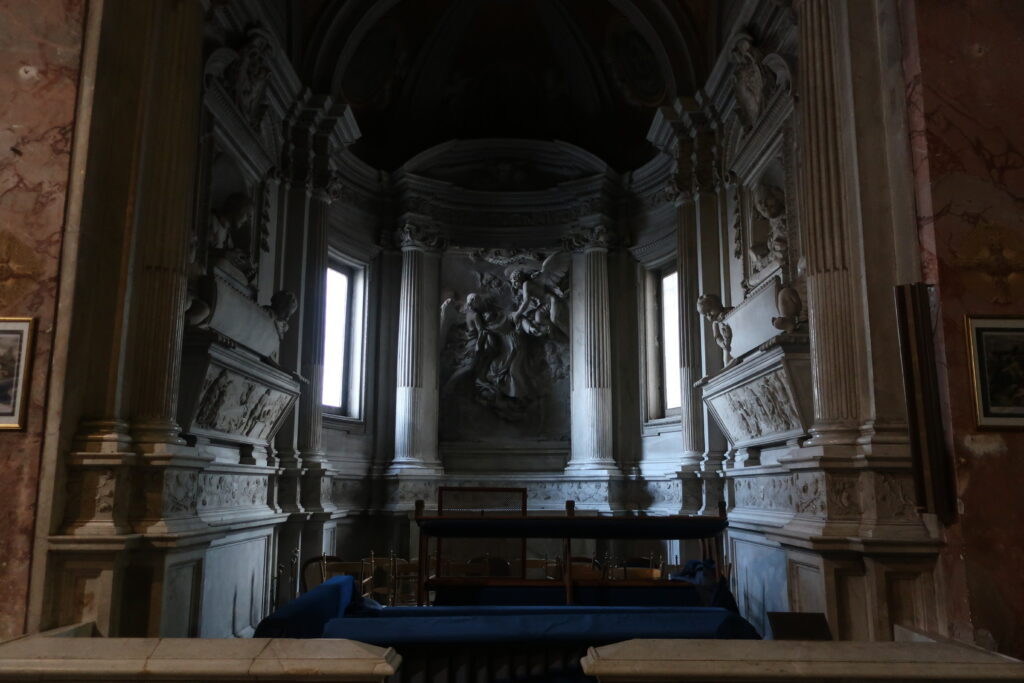
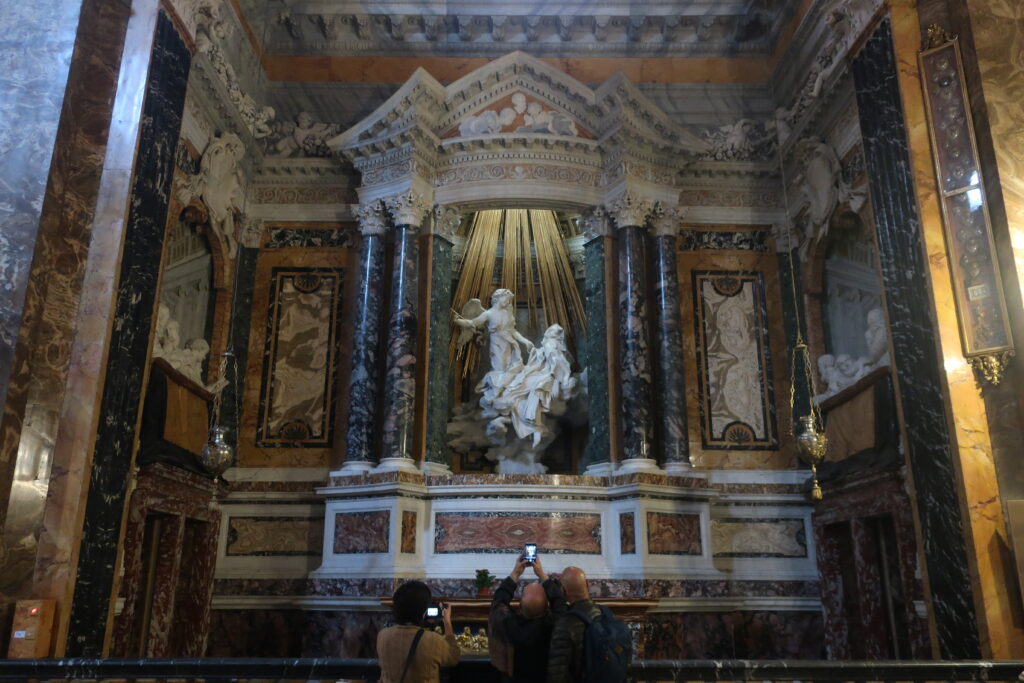
These are the masterpiece chapels of Bernini's grand era, but it is interesting to compare them with these. For more information, please refer to the previous article(24) Bernini's Raimondi Chapel - A spectacle of stunning light! Bernini as playwright and director."and(27) Bernini's "The Ecstasy of Saint Teresa" - A masterpiece of Baroque art! The marvelous illusions of the Cornaro Chapel!"for more information.
Now, let us actually visit this church to see "Blessed Ludovica Antoni".
Visit the Church of San Francesco a Ripa
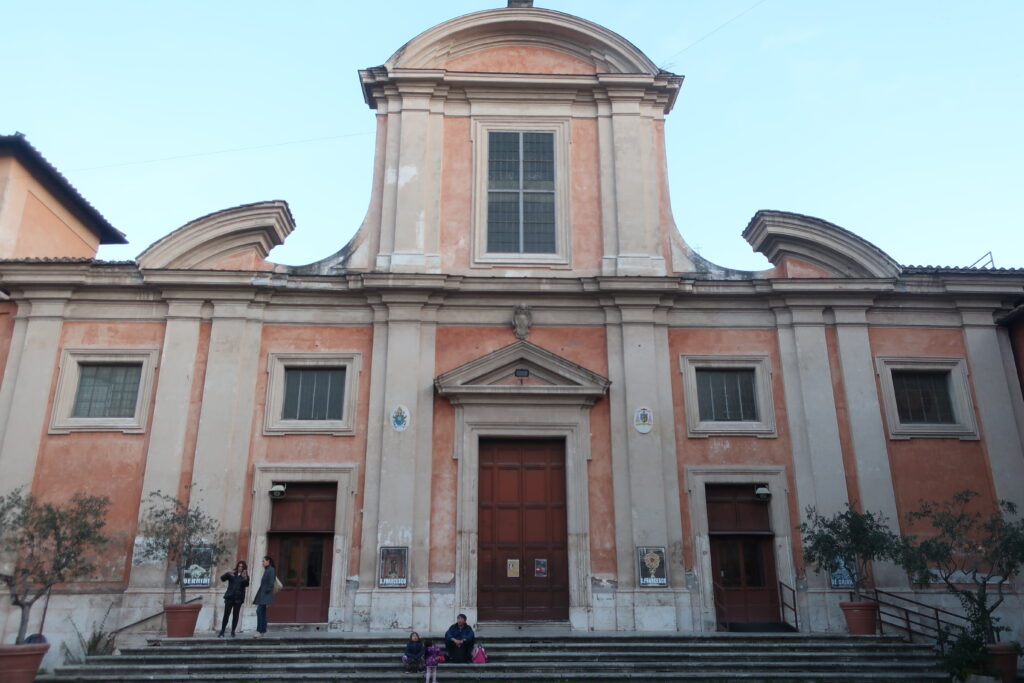
This church is located in the Trastevere district, a short distance from the area where the Colosseum and Piazza di Spagna are located. Therefore, it is a little difficult to access. However, the Raimondi Chapel and the famous "Martyrdom of St. Cecilia" are also located in this neighborhood.Basilica of Santa Cecilia in TrastevereIt is recommended to visit all of them at once.
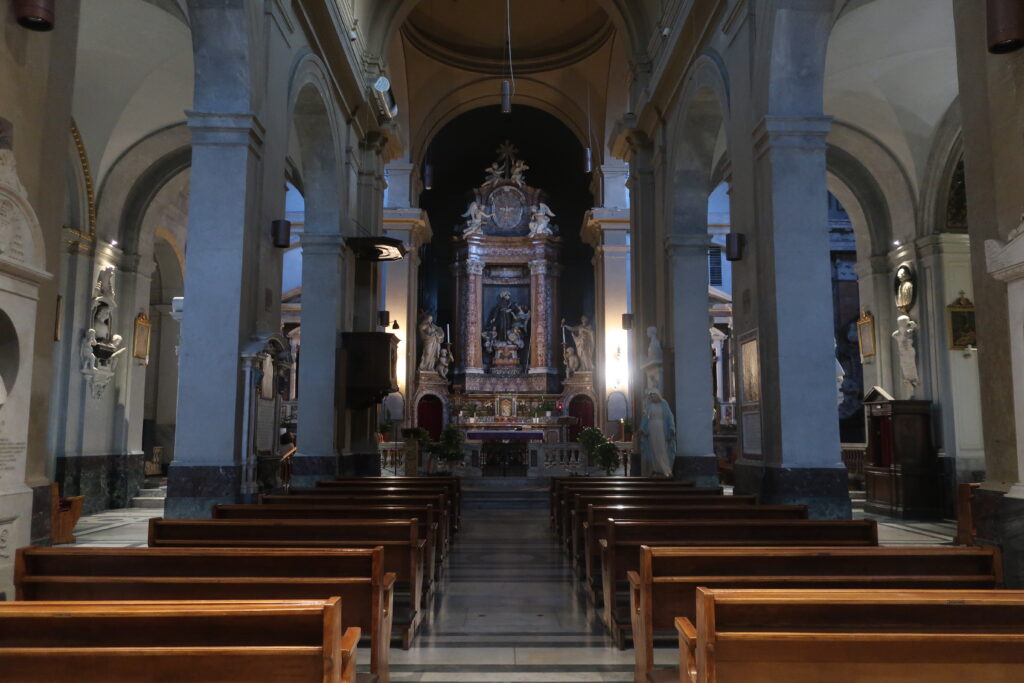
I came at dusk, so the interior was dimly lit. I was able to enjoy the quiet atmosphere of the church as much as I wanted because there were almost no people there.
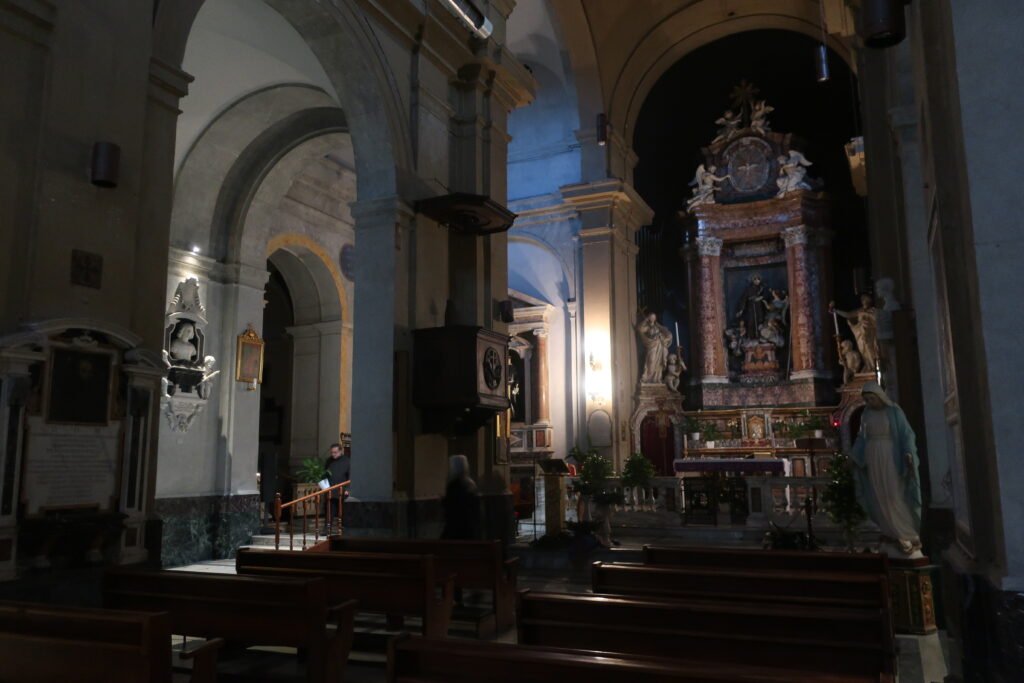
Near the central altar. Compared to the large churches I have seen so far, this church is quite small. However, it feels very cozy and even homey.
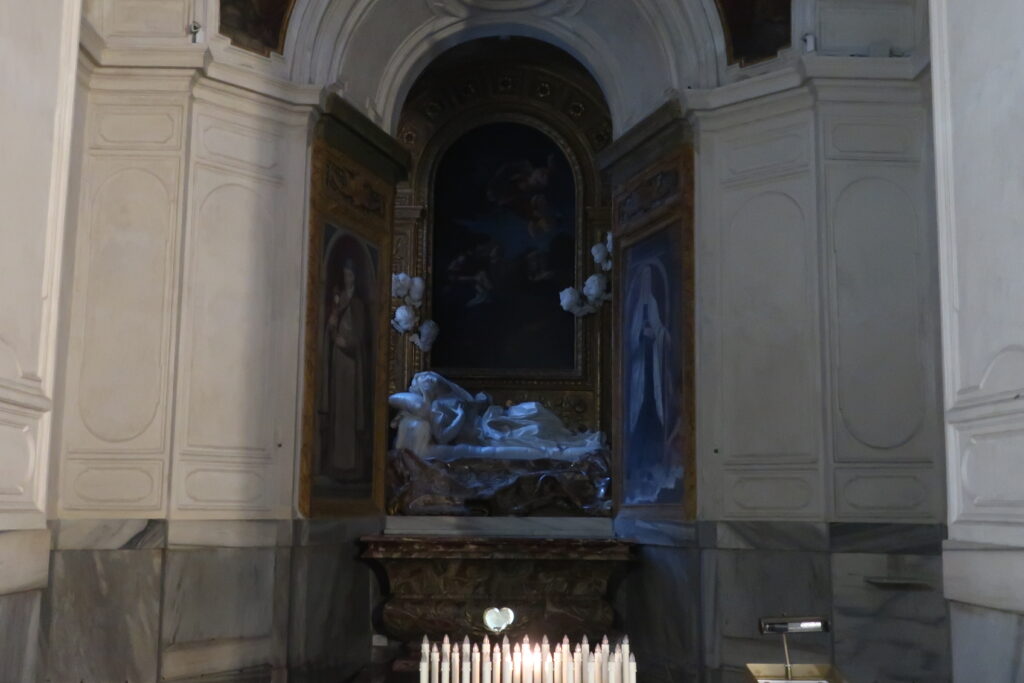
This is "Blessed Ludovica Albertoni". The interior of the hall is dimly lit at dusk. The sculpture is illuminated by light through Bernini's signature light window. It seems as if it is illuminated by moonlight, which is probably unique to this time of day. The beauty and fantastic atmosphere took my breath away.
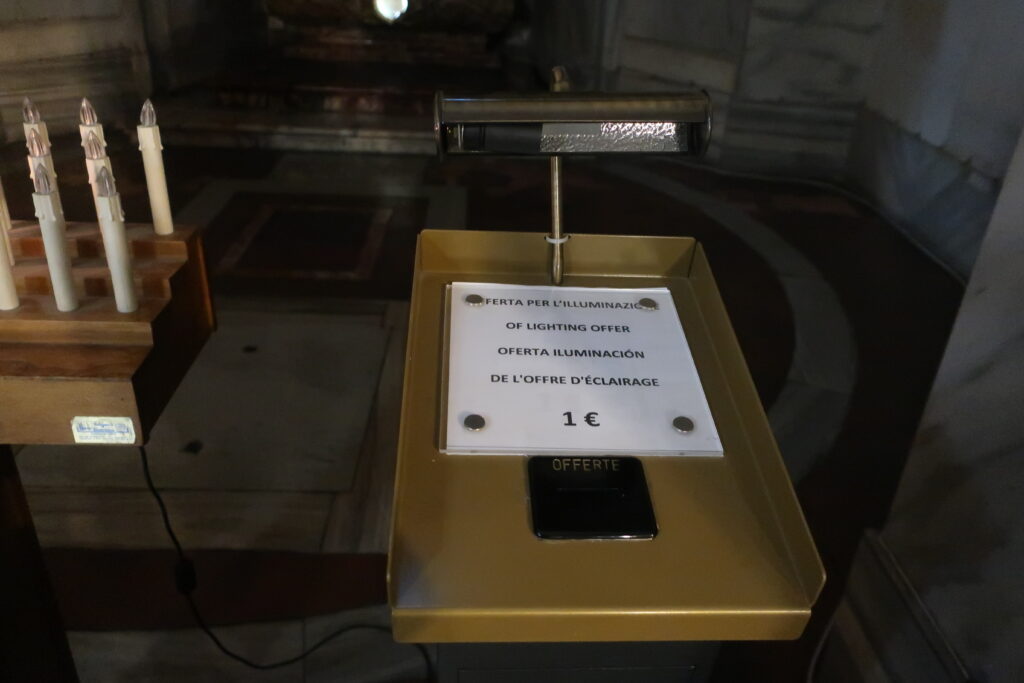
The church is also equipped with a light fixture. A single euro is all it takes to turn on the lights. Dr. Masumi IshinabeThere is no better example of church lighting detracting from the effect of a work than in this chapel. If there are lights on, they should be turned off.I was warned to turn it on, but since I'm here, let's turn it on. I dare you to feel the difference.
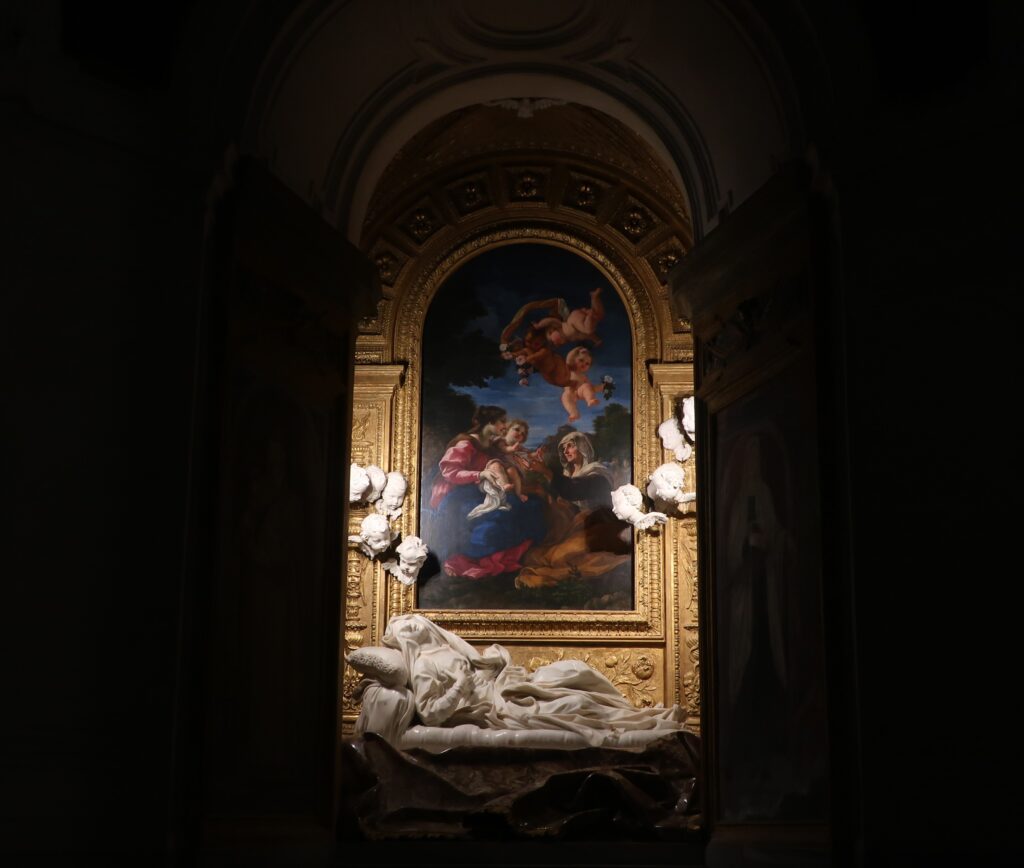
Yes, it was easier to see with the lights on. However, the fantastic and mysterious atmosphere I felt earlier has gone away! The light had to be the light that Bernini had intended. The light coming through the window is what makes the statue what it is!
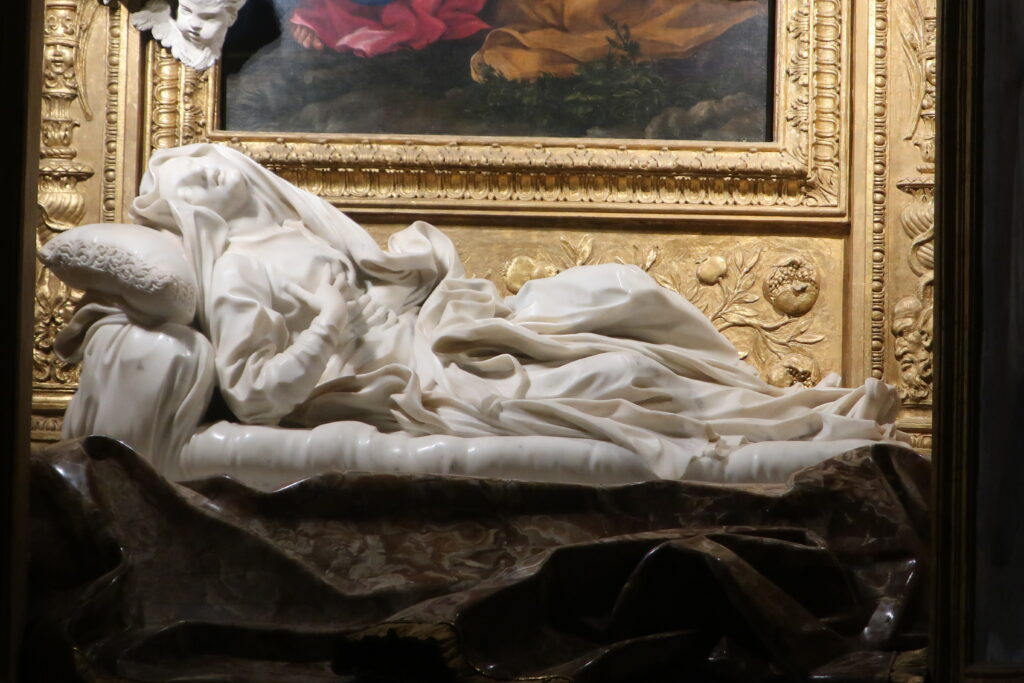
St. Ludovica's ecstatic expression is certainly Bernini at his best.
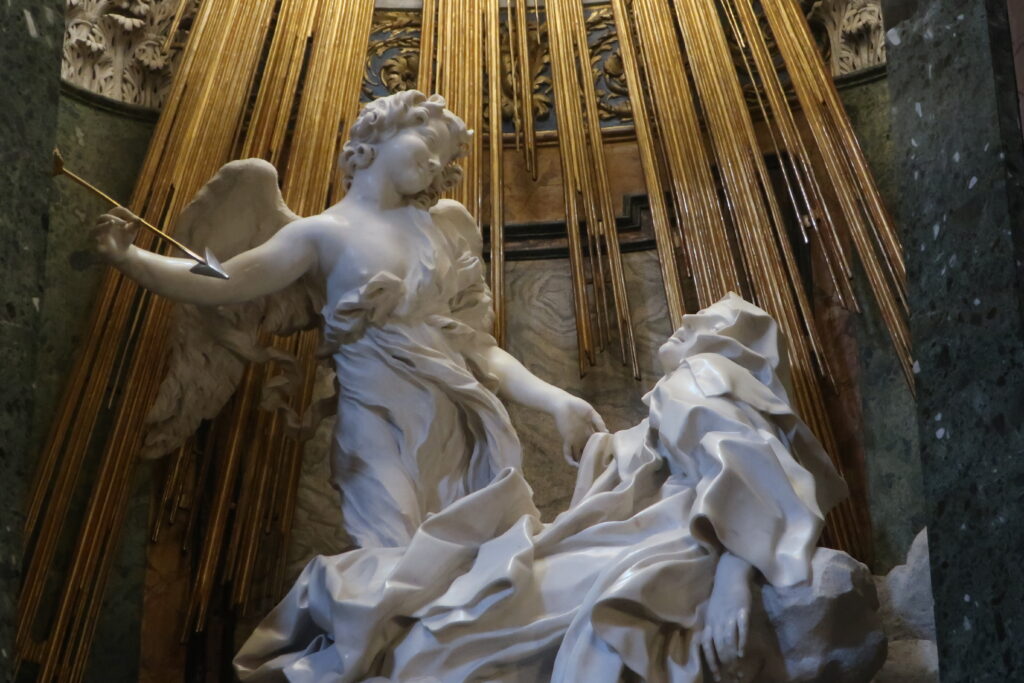
And compared to "The Ecstasy of Saint Teresa," "Ludovica" shows a much softer or more modest expression of the robe. The impression is that she quietly and softly took on the joy of the law, rather than the vibrancy of mystery. It is only natural that the expression of Bernini's work in his prime, full of energy, is different from that of the work in his old age, when he spent the last years of his life in a difficult position.
Masumi Ishinabe is a member ofThe author does not always agree with Pope Hennessy's assessment of Bernini's work, and he does not agree with this statement, but it is certainly an insight. The evangelical Ludovica has a spiritual depth appropriate to its age, as well as a creativity that makes it hard to believe that it was made by a man in his mid-seventies."He stated, and I agree with him exactly.
It is still "The Laws of Saint Teresa" that has a sense of perfection as a work, its originality, and its overwhelming power to open up a new era.
But "Ludovica the Blessed" has excellence in it. There is no doubt about that. There is no doubt that it will go down in history as the masterpiece of Bernini's last years.

Still, the beauty of "Ludovica the Blessed" shining in the dark night...!
I was right to come at this time. If I have a chance to come here again, I will come at this time.
Bernini has perfect control over lighting. He also calculated how the light would illuminate the sculptures. The light from a light source can never reproduce this. We can understand the meaning of Masumi Ishinabe's careful attention to detail.
Well, it was truly a wonderful experience. It may be a minor spot in Rome, but it is a very impressive church. If you are ever in the Trastevere area, I highly recommend a visit to this church.
be unbroken
*The following photos are my Bernini notes. I hope you will find them useful.
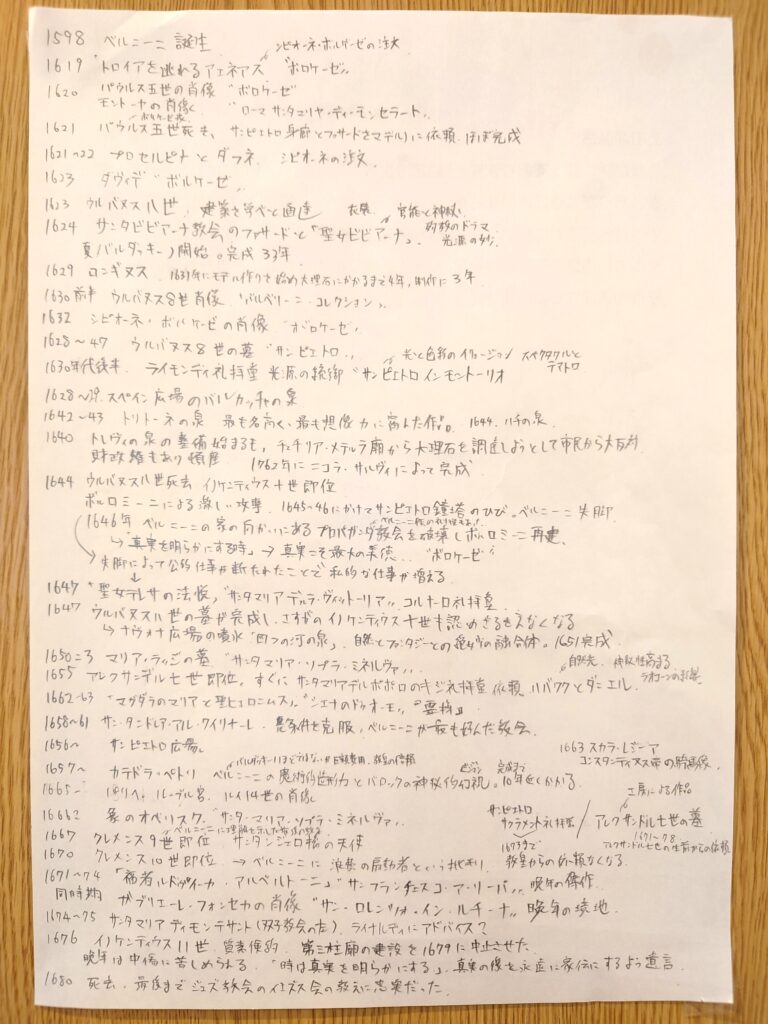
*The list of articles in the "Rome Travel Journal" can be found atCategory page hereindicates direction or goal (e.g. "to")
*Please visit this category page for recommended books to learn about Rome and Italy.
The Rise and Fall of the Roman Empire, the Vatican, and Roman Catholicism."
The Italian Renaissance and the Revolution in Knowledge."
Next Article.
Click here to read the previous article.
Related Articles











